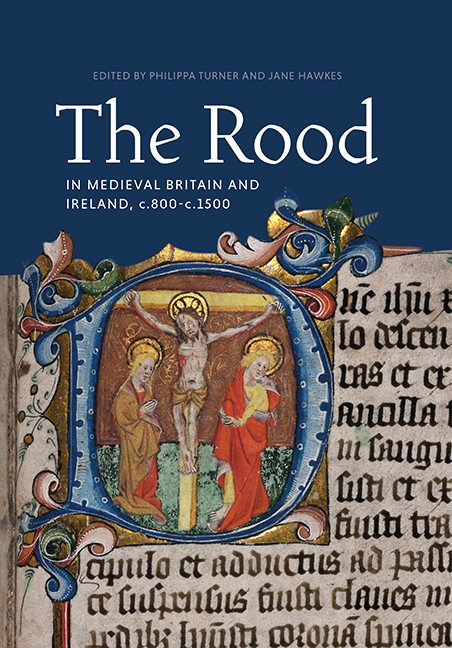Book contents
- Frontmatter
- Contents
- List of Illustrations
- List of Contributors
- Acknowledgements
- List of Abbreviations
- 1 Introduction: Rethinking the Rood
- 2 Approaching the Cross: The Sculpted High Crosses of Anglo-Saxon England
- 3 The Mark of Christ in Wood, Grass and Field: Open-Air Roods in Old English Medical Remedies
- 4 Twelfth-Century English Rood Visions: Some Iconographic Notes
- 5 Crosses, Croziers and the Crucifixion: Twelfth-Century Crosses in Ireland
- 6 From Religious Artefacts to Symbols of Identity: The Role of Stone Crosses in Galician National Discourse
- 7 The Rood in the Late Medieval English Cathedral: The Black Rood of Scotland Reassessed
- 8 The Cross of Death and the Tree of Life: Franciscan Ideologies in Late Medieval Ireland
- 9 Heralding the Rood: Colour Convention and Material Hierarchies on Late Medieval English Rood Screens
- 10 Reframing the Rood: Fifteenth-Century Angel Roofs and the Rood in East Anglia
- Bibliography
- Index
- Already Published
- Plate Section
8 - The Cross of Death and the Tree of Life: Franciscan Ideologies in Late Medieval Ireland
Published online by Cambridge University Press: 07 November 2020
- Frontmatter
- Contents
- List of Illustrations
- List of Contributors
- Acknowledgements
- List of Abbreviations
- 1 Introduction: Rethinking the Rood
- 2 Approaching the Cross: The Sculpted High Crosses of Anglo-Saxon England
- 3 The Mark of Christ in Wood, Grass and Field: Open-Air Roods in Old English Medical Remedies
- 4 Twelfth-Century English Rood Visions: Some Iconographic Notes
- 5 Crosses, Croziers and the Crucifixion: Twelfth-Century Crosses in Ireland
- 6 From Religious Artefacts to Symbols of Identity: The Role of Stone Crosses in Galician National Discourse
- 7 The Rood in the Late Medieval English Cathedral: The Black Rood of Scotland Reassessed
- 8 The Cross of Death and the Tree of Life: Franciscan Ideologies in Late Medieval Ireland
- 9 Heralding the Rood: Colour Convention and Material Hierarchies on Late Medieval English Rood Screens
- 10 Reframing the Rood: Fifteenth-Century Angel Roofs and the Rood in East Anglia
- Bibliography
- Index
- Already Published
- Plate Section
Summary
Surviving Franciscan friaries in Ireland display a variety of plant motifs, ranging from single leaves and vine tendrils to more complex images of the Tree of Life. Combined with representations of the crucifixion, these images not only visualise a Christian paradox of the cross as a death-bearing and life-giving object but also express aspects of Franciscan identity. That identity was shaped by Francis’ devotion to the cross and subsequently developed by leading Franciscan thinkers who utilised the Tree of Life to imagine the life of Christ, to present the Order as a living organism and their founder as ‘a mustard seed which grew into a great tree’, and to express a sense of both communal and personal growth as well as the message of salvation.
The passion-centred piety of the Franciscan Order found its material manifestation in the ubiquitous presence of crosses, which in the Franciscan churches of the Order's Italian heartland were often associated from the late fourteenth century with two iconographic themes: the narrative Legend of the True Cross that presented the story of the wood on which Christ was crucified, and the allegorical Tree of Life based on Bonaventure's contemplative work of the Lignum vitae. While the Irish Franciscan friaries do not display such lavish and developed iconographic schemes, an investigation into the surviving imagery and texts composed or copied by the Irish friars that discuss the story of the cross shows that the seemingly disjoined Irish material fits into the body of Franciscan visual culture and expresses a similar preoccupation with the cross as a living and life-giving organism.
Despite their now fragmentary nature, iconographic schemes in Irish friaries allow us to explore the use of the cross and plant imagery in order to view the transmission, reception and transformation of these important Franciscan themes in Ireland. Crosses can still be seen depicted on friary walls or engraved on tombs, with the friaries originally displaying large crosses on rood screens, in stained glass and as part of altar furnishings (Figs 8.1a, 8.2b). Some of these representations appeared in the areas reserved for the friars, but some including the monumental rood or tombs set in the nave were seen by a lay congregation.
- Type
- Chapter
- Information
- The Rood in Medieval Britain and Ireland, c.800-c.1500 , pp. 125 - 144Publisher: Boydell & BrewerPrint publication year: 2020



